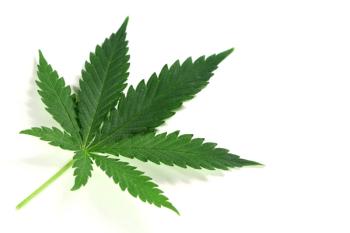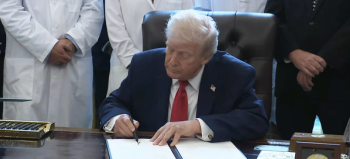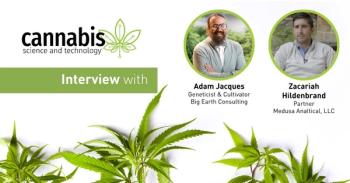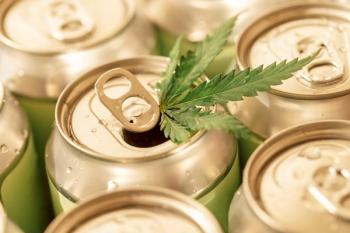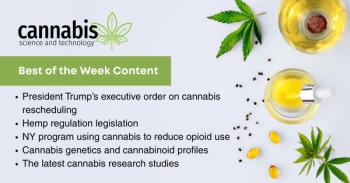
Cannabis Cultivator Operations: Interview with Zacariah Hildenbrand and Adam Jacques
Zacariah Hildenbrand, PhD and Adam Jacques discuss what to consider when deciding between indoor, outdoor, and hybrid cannabis cultivation.
In this interview, Zacarariah Hildenbrand, PhD, partner of Medusa Analytical, LLC Adam Jacques, Geneticist and Cultivator of Big Earth Consulting, discuss some of the concerns that may arise when choosing between indoor, outdoor, and hybrid cannabis cultivation.
Transcript:
Madeline Colli: What should a cannabis cultivator consider when deciding between indoor, outdoor, or hybrid growing operations?
Adam Jacques: When you're growing outside, you have no control over your temperature, [or] if it's raining. Environmental controls are not really in your control anymore, if you're growing outside. If you're growing in a greenhouse, you have limited-to-extreme control based on how much you spent on your greenhouse and what you're looking for. And indoors, you have full control over environmentals. So, that's like a really major thing, like you need to live in the right area to grow outside. If you have a monsoon season in the middle of flower, it's probably not the best to be growing, at least for flower, outdoors. Hybrid is, as far as I'm concerned, the way. Using greenhouse, a nice greenhouse technology with supplemental lighting, something that mimics the sun, and keeping it nice and contained and sealed is the premier way to grow if you're growing for flower, I would say. And then, indoor growing, you can really grow the best cannabis in the world indoors. It is not extremely cost effective, so therefore...how much you have to charge goes way up. But there's nothing finer than indoor flower, but it's a very specific, almost niche market at this point.
Zacariah Hildenbrand: Yeah, I would echo those sentiments in that it really just depends on what your final applications are. If you're growing trying to get the best quality and you're trying to get the best commodity price, it's going to cost you probably $350 to $500 a pound to produce indoors, but you're going to probably get a better-quality product, and you're going to get better testing data, which allows you to sell it at a higher commodity price. As Adam alluded to there, the greenhouse option is nice because you can still kind of control the environmental conditions. You can add supplemental lighting, which allows you to drive up the yield and the phytochemical content to get better terpenes, better cannabinoids. You also get the benefit of the sun, so it's a little bit more cost effective than indoor. And then outdoor, in my opinion, I think it would be for "Hey, we're just going to produce a large amount of really nice biomass for extraction. We need to do so cheaply." And so, you know, there's that. I think the hemp industry really exemplifies how challenging outdoor cultivation could be, because everyone just thought, "I bought these seeds online. I'll just put them outside, and when I harvest them in two, three months, I'm going to make a ton of money." And they don't account for the fact that, okay, pollen, pollination, errant weather, all these things can go wrong, obviously.
Jacques: Bugs.
Hildenbrand: Yeah, bugs, right? And so, I mean, as you remember that first summer we had in Oklahoma where it was like, looks great. Next day, army worm infestation. Where did these things come from? They were not there yesterday, and then we're toast, right? So outdoor cultivation, very challenging, but can be more cost-effective. Indoor obviously, is controlled environmental agriculture, so you have greater control over things. It is more expensive, but you produce better products, so it's really a trade off from what you want to do.
Jacques: I feel like if you're not doing any sort of post-processing on your product to clean it up, growing outdoors [is] kind of a bad idea. I do know that there is a a subsection of the community, and I mean no disrespect whatsoever, if you want to smoke outdoor, that's great. I get it, and I get the zero energy growing, I understand. But it's not strawberries, right? It's not potatoes. You can't take them and rinse them off and clean it, and then smoke it, right? So, you're smoking all of the dust, all of the pollen, and all of the mold, every bug that climbed on it. You know, one year a bird dropped half a dead frog on one of our plants outside. You can't take that and scrub it off like you would scrub off fruit, right? And so, getting it clean enough to be a smokeable commodity outdoors without extreme controls, it's tough. It's tough. They test with all sorts of weird stuff outside on the plant matter. But if you're clarifying it down using extraction methodologies or something like that, like, it's
generally fine.
Newsletter
Unlock the latest breakthroughs in cannabis science—subscribe now to get expert insights, research, and industry updates delivered to your inbox.

